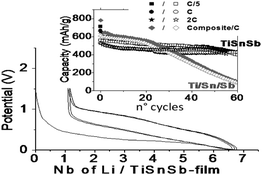TiSnSb a new efficient negative electrode for Li-ion batteries: mechanism investigations by operando-XRD and Mössbauer techniques
Abstract
We report the electrochemical study of TiSnSb towards Li, as a negative electrode for Li-ion batteries. TiSnSb can reversibly take up more than 5 lithiums per formula unit leading to reversible capacities of 540 mA h g−1 and 4070 mA h cm−3 at 2 C rate. From complementary operandoXRD and Mössbauer

- This article is part of the themed collection: Advanced Materials for Lithium Batteries

 Please wait while we load your content...
Please wait while we load your content...